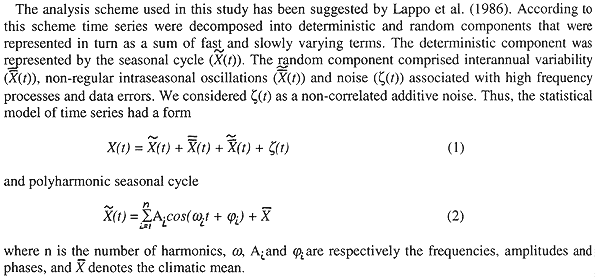In the present study we analyze climatic changes of characteristics of seasonal cycle of SST's and their relationships with changes of annual and seasonal means with respect to above described North Pacific climate shift.
DATA AND METHODS
In the present study we used data from the Reconstructed Reynolds SST data provided by the NOAA-CIRES Climate Diagnostics Center, Boulder, Colorado, from their Web site at http://www.cdc.noaa.gov/.
To produce this data set the dominant empirical orthogonal functions modes were used as basis functions and were fitted to the in situ data to determine the time dependence of each mode. A global fields of SSTs were then reconstucted from these spatial and temporal modes (Reynolds et al., 1995. Smith et al., 1995). This data set contains monthly means from January 1950 through May 1998 on the 2。?atitude x 2。?ongitude grid.

Making use of the above model amplitudes and phases of annual and semiannual cycles have been estimated for each pentad beginning from 1951 (i.e. for 1951-1955, 1956-1960,........., 1991-1995). Subsequently, anomalies of the above characteristics have been calculated by subtracting“climatic”amplitudes and phases, which were estimated for the whole time period (1951-1995). Analogously, anomalies of anual and seasonal (winter and summer) means have been calculated for each pentad.
RESULTS
Mean multi-year climate and pentadal anomalies of annual means of SST's are presented in Figure 1. It is clearly seen that during first five pentads the central part of the North Pacific is dominated by positive anomalies of SST's with maximum values up to 0.8℃ (1961-1965). Negative anomalies are located in the south-eastern North Pacific. Their maximum values reach -0.6℃ (1971-1975). Remarkably, during this period subsequent pentad-to-pentad strengthening and weakening of SST's anomalies is noticeable. While pentads 1951-1955, 1961-1965 and 1971-1975 reveal increased anomalies, during 1956-1960 and 1966-1970 anomalies were decreased. This fact can be interpreted as a manifestation of quasi-decadal variations of the North Pacific SST's.
Starting with pentad 1976-1980 spatial distribution of anomalies is reversed i. e. central North Pacific is dominated by negative SST's anomalies, and south-eastern North Pacific - by positive anomalies. We note here that behavior of anomalies during this period (1976-1995) is quite different to that during 1951-1975. Negative anomalies with maximum values about -0.8℃ are stable during this period. Positive anomalies reveal gradual increase and reach 0.6℃ in 1991-1995. Therefore, space-time structure of anomalies of annual mean SST's clearly indicate North Pacific climate shift of mid 70-ties.